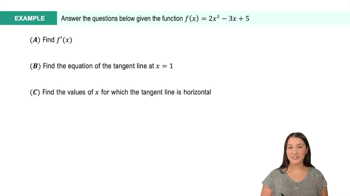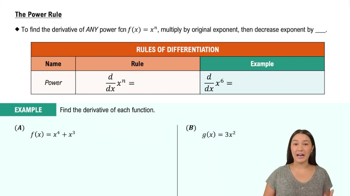Table of contents
- 0. Functions7h 52m
- Introduction to Functions16m
- Piecewise Functions10m
- Properties of Functions9m
- Common Functions1h 8m
- Transformations5m
- Combining Functions27m
- Exponent rules32m
- Exponential Functions28m
- Logarithmic Functions24m
- Properties of Logarithms34m
- Exponential & Logarithmic Equations35m
- Introduction to Trigonometric Functions38m
- Graphs of Trigonometric Functions44m
- Trigonometric Identities47m
- Inverse Trigonometric Functions48m
- 1. Limits and Continuity2h 2m
- 2. Intro to Derivatives1h 33m
- 3. Techniques of Differentiation3h 18m
- 4. Applications of Derivatives2h 38m
- 5. Graphical Applications of Derivatives6h 2m
- 6. Derivatives of Inverse, Exponential, & Logarithmic Functions2h 37m
- 7. Antiderivatives & Indefinite Integrals1h 26m
3. Techniques of Differentiation
Basic Rules of Differentiation
Problem 84b
Textbook Question
The following limits represent f'(a) for some function f and some real number a.
b. Evaluate the limit by computing f'(a).
lim x🠂1 x¹⁰⁰-1 / x-1
 Verified step by step guidance
Verified step by step guidance1
Step 1: Recognize that the given limit represents the derivative of a function at a point. Specifically, it is the definition of the derivative f'(a) at a = 1 for the function f(x) = x^{100}.
Step 2: Recall the definition of the derivative: f'(a) = \lim_{x \to a} \frac{f(x) - f(a)}{x - a}. In this case, f(x) = x^{100} and a = 1, so f(1) = 1^{100} = 1.
Step 3: Substitute f(x) = x^{100} and f(1) = 1 into the derivative definition: \lim_{x \to 1} \frac{x^{100} - 1}{x - 1}.
Step 4: Notice that the expression \frac{x^{100} - 1}{x - 1} is an indeterminate form 0/0 as x approaches 1. To resolve this, apply L'Hôpital's Rule, which states that if \lim_{x \to c} \frac{f(x)}{g(x)} = \frac{0}{0}, then \lim_{x \to c} \frac{f(x)}{g(x)} = \lim_{x \to c} \frac{f'(x)}{g'(x)}.
Step 5: Differentiate the numerator and the denominator separately: f'(x) = 100x^{99} and g'(x) = 1. Then, apply L'Hôpital's Rule: \lim_{x \to 1} \frac{100x^{99}}{1}. Evaluate this limit by substituting x = 1.
Recommended similar problem, with video answer:
 Verified Solution
Verified SolutionThis video solution was recommended by our tutors as helpful for the problem above
Video duration:
4mPlay a video:
Was this helpful?

 3:59m
3:59mWatch next
Master Derivatives of Linear Functions with a bite sized video explanation from Callie
Start learningRelated Videos
Related Practice







